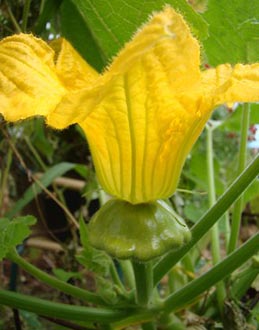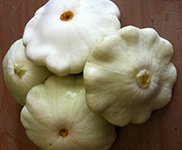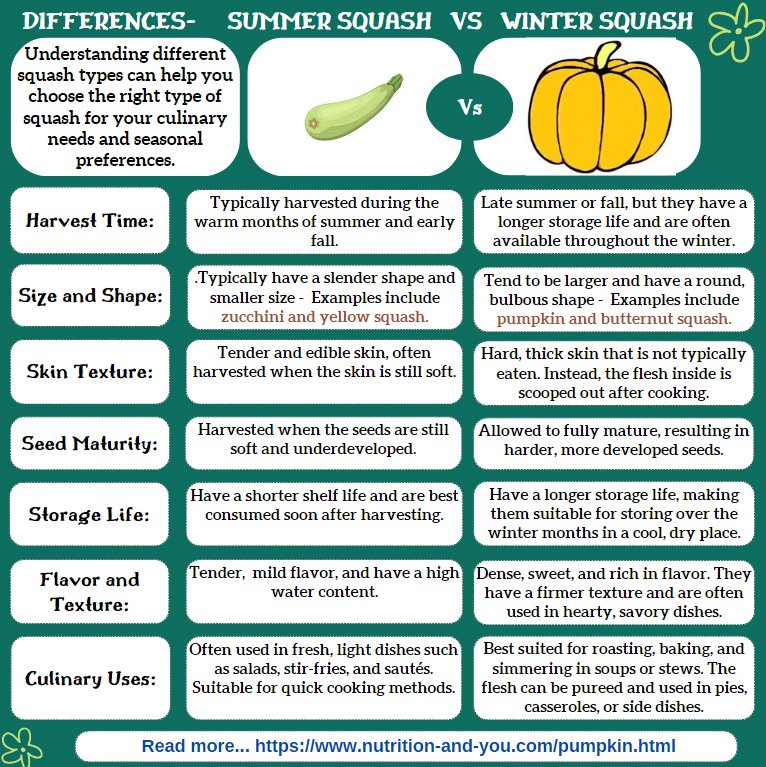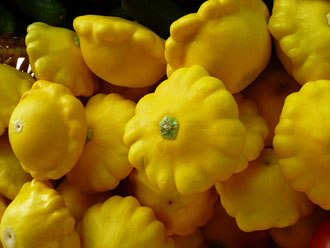Pattypan squash Nutrition facts
Pattypan squash, also known as scallop squash, is a variety of summer squashes originated from Mexico. Scallop squash is generally picked up while they are young, immature, and tender, at a stage, they are sweeter and more appetizing.
Native Americans have long been aware of scallop squash cultivation for centuries. Botanically, they belong to the Cucurbitaceae or gourd family of vegetables and closely related to other summer squash varieties such as zucchini, crookneck squash, cocozelle, etc.
Scientific name: C. pepo var. clypeata.
 |
| Pattypan squash. Note golden-yellow blossom. Photo:vasenka. |
Pattypan squash is a rapidly growing half-shrubby plant. It prefers well-drained, fertile sandy soils for best growth. After about 35-45 days of the plantation, yellow flowers appear, which soon develop into attractive, flattened, disc-like squash pods with "scallop shell-like" undulating edges.

|
| White scallop squash. Photo courtesy: twisted-string. |
Pattypan squash comes in white, yellow, and deep green colors. Usually, young, tender fruits are picked at their early stages for cooking. If left alone, it soon enlarges in size, the outer peel becomes tougher, and the seeds turn harder, which makes the whole squash become inedible and unappetizing. Use protective gloves and a knife while harvesting to avoid contact with prickly stems and leaves.
Apart from its fruits, pattypan flowers are also one of the sought-after delicacies employed in main and side dishes. Male blossoms are generally picked up while female flowers are left to grow into fruits. However, often farmers pick up a few female flowers with intact, tiny fruit (baby scallop squash) and sell them in the markets, which command a special price.
See the differnces between Summer and Winter variety squashes in an infographic:
 |
Health benefits of pattypan squash
Just like other summer variety squash types, scallop squash is one of the very low-calorie vegetables. 100 grams of raw fruit carry just 18 calories. It contains no saturated fats or cholesterol. Its peel is a good source of dietary fiber.
Fresh pattypan fruits carry relatively more vitamin A than zucchini; provide about 217 IU per 100 g.
Golden-yellow skin scallopini is a good source of flavonoid poly-phenolic antioxidants such as carotenes, lutein, and zeaxanthin. These compounds help scavenge harmful oxygen-derived free radicals and reactive oxygen species (ROS) from the body that play a role in aging and various disease processes.
pattypan squash holds relatively more amounts of folates, pyridoxine, niacin than zucchini. It provides 30 µg or 7.5% of RDA per 100 gm. Folate is a necessary element for cell division and DNA synthesis. When taken adequately during early pregnancy, it may help prevent neural tube defects in the fetus.
It has less sodium (1 mg/100 g) and moderate levels of potassium (187 mg/100 g), an important intra-cellular electrolyte. Potassium is a heart-friendly electrolyte and helps bring the reduction in blood pressure and heart rates by countering the pressing effects of sodium.
Fresh scallop squash indeed is an excellent source of vitamin-C. It provides about 18 µg or 30% of the daily required levels per 100 g. Vitamin C is a water-soluble, natural antioxidant.
Further, pattypan squash carry modest levels of other B-complex groups of vitamins like thiamin, pyridoxine, riboflavin, and minerals like calcium, iron, manganese, phosphorus, and zinc.
| Principle | Nutrient Value | Percent of RDA |
|---|---|---|
| Energy | 18 Kcal | 1% |
| Carbohydrates | 3.84 g | 3% |
| Protein | 1.20 g | 2% |
| Total Fat | 0.20 g | 1% |
| Cholesterol | 0 mg | 0% |
| Dietary Fiber | 1.2 g | 3% |
| Vitamins | ||
| Folates | 30 µg | 7.5% |
| Niacin | 0.600 mg | 4% |
| Pantothenic acid | 0.102 mg | 2% |
| Pyridoxine | 0.109 mg | 8% |
| Riboflavin | 0.030 mg | 2% |
| Thiamin | 0.070 mg | 6% |
| Vitamin A | 217 IU | 7% |
| Vitamin C | 18 mg | 30% |
| Vitamin E | 0.13 mg | <1% |
| Vitamin K | 3.3 µg | 3% |
| Electrolytes | ||
| Sodium | 1 mg | 0.5% |
| Potassium | 187 mg | 4% |
| Minerals | ||
| Calcium | 19 mg | 1.9% |
| Iron | 0.40 mg | 5% |
| Magnesium | 23 mg | 4% |
| Manganese | 0.157 mg | 6% |
| Phosphorus | 36 mg | 5% |
| Selenium | 0.2 µg | <1% |
| Zinc | 0.29 mg | 3% |
| Phyto-nutrients | ||
| Carotene-ß | 130 µg | -- |
| Crypto-xanthin-ß | 0 µg | -- |
| Lutein-zeaxanthin | 2308 µg | -- |
Selection and storage
 |
| Scallopini squash in a market. Photo: notionscapital. |
Summer squash, including pattypan, begins arriving in the markets from May until the end of September. In the markets, buy fresh, small to medium, bright young fruits. Avoid, very large, hard-skinned, and overmature ones as they are unappetizing. Also, avoid those with cuts, spots, bruises, etc.
At home, store fresh squash as you do for other summer squash like zucchini, inside a plastic bag and place inside the vegetable compartment in the refrigerator, set at appropriate relative humidity. They can be stored fresh for up to 2-3 days.
Preparation and serving methods
Pattypan squash is used in a variety of recipes like stuffed, grilled, roasted, etc. At home, wash fruits in cold water to remove any surface sand. Trim the stem end. A tender pattypan can be used with intact skin. Cut the fruit into small cubes/wedges as you may desire to use them in cooking.
As in zucchini blossoms, scallopini flowers are also edible delicacies. In general, male blossoms picked up; allowing female flowers to continue to grow into fruits. To prepare, open up flowers and carefully inspect for insects. Pull off any calyces attached firmly at the base.
Here are some serving tips:
Tender scallopini slices can be added to salads.
Pattypan squash blossoms dipped in batter and fried in oil and enjoyed as delicious fritters.
As in pumpkin, pattypan can be employed in pies, cakes, custards, etc.
Its whole fruit can be stuffed with peas, corn, cheese, mushrooms, and herbs and baked.
Safety profile
Pattypan squash rarely causes any allergic reactions. (Medical disclaimer).
Also read ≻≻-
≻≻- Acorn squash nutrition facts.
≻≻- Spaghetti squash nutrition facts.
≻≻- Crookneck squash nutrition facts.
≻≻-Back to Vegetables from Pattypan Squash. Visit here for an impressive list of vegetables with complete illustrations of their nutrition facts and health benefits.
≻≻-Back to Home page.
Further reading:
Stanford School of Medicine Cancer information Page- Nutrition to Reduce Cancer Risk.